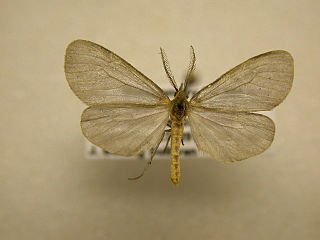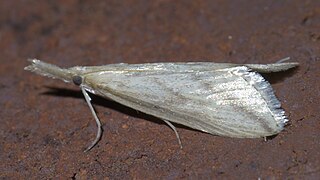
Pagara is a monotypic moth genus in the family Erebidae. Its only species, Pagara simplex, the mouse-colored lichen moth, is found in North America, where it has been recorded from Alabama, Arkansas, Florida, Georgia, Illinois, Indiana, Iowa, Kansas, Kentucky, Maryland, Mississippi, New Hampshire, North Carolina, Ohio, Oklahoma, South Carolina and Tennessee. Both the genus and species were described by Francis Walker in 1856.

Chrysendeton medicinalis, the bold medicine moth, is a moth in the family Crambidae. It was described by Augustus Radcliffe Grote in 1881. It is found on North America, where it has been recorded from Alabama, Florida, Georgia, Illinois, Indiana, Kentucky, Maryland, Mississippi, North Carolina, Ohio, Pennsylvania, South Carolina, Tennessee, Texas and West Virginia.

Elophila gyralis, the waterlily borer moth, is a moth in the family Crambidae. It was described by George Duryea Hulst in 1886. It is found in eastern North America, where it has been recorded from Alabama, Florida, Georgia, Illinois, Indiana, Iowa, Louisiana, Maine, Maryland, Massachusetts, Michigan, Minnesota, Mississippi, New Brunswick, New Hampshire, New Jersey, New York, North Carolina, Nova Scotia, Ohio, Oklahoma, Ontario, Pennsylvania, Quebec, South Carolina, Tennessee, Texas and Wisconsin.

Parapoynx allionealis, the watermilfoil leafcutter moth, is a moth in the family Crambidae. It was described by Francis Walker in 1859. It is found in North America, where it has been recorded from Alabama, Florida, Georgia, Indiana, Louisiana, Maine, Manitoba, Maryland, Massachusetts, Michigan, Minnesota, Mississippi, New Brunswick, New Hampshire, New Jersey, New York, North Carolina, Nova Scotia, Ohio, Oklahoma, Ontario, Quebec, South Carolina, Tennessee and Texas.
Parapoynx seminealis, the floating-heart waterlily moth, is a moth in the family Crambidae. It was described by Francis Walker in 1859. It is found in North America, where it has been recorded from Florida, Georgia, Massachusetts, Mississippi, New Hampshire, Rhode Island, South Carolina and Texas.

Microcrambus biguttellus, the gold-stripe grass-veneer, is a moth in the family Crambidae. It was described by William Trowbridge Merrifield Forbes in 1920. It is found in North America, where it has been recorded from Alabama, Florida, Georgia, Illinois, Indiana, Kentucky, Maine, Manitoba, Maryland, Massachusetts, Michigan, Minnesota, Mississippi, New Brunswick, New Jersey, New York, North Carolina, Nova Scotia, Ohio, Oklahoma, Ontario, Quebec, South Carolina, Tennessee, Texas, West Virginia and Wisconsin. It has also been recorded from Cuba and Puerto Rico.
Microcrambus minor is a moth in the family Crambidae. It was described by William Trowbridge Merrifield Forbes in 1920. It is found in North America, where it has been recorded from Alabama, Florida, Illinois, Indiana, Manitoba, Maryland, Massachusetts, Minnesota, Mississippi, New Hampshire, New York, North Carolina, Ohio, Oklahoma, Ontario, Pennsylvania, Quebec, South Carolina, Tennessee, West Virginia, Virginia, and Wisconsin.
Thaumatopsis floridella, the Floridian grass-veneer, is a moth in the family Crambidae. It was described by William Barnes and James Halliday McDunnough in 1913. It is found in North America, where it has been recorded from coastal areas in Florida, Georgia, Mississippi, South Carolina and North Carolina, New Jersey, New York, and Rhode Island. It is also found in Cuba.

Lipocosma sicalis is a moth in the family Crambidae. It was described by Francis Walker in 1859. It is found in North America, where it has been recorded from Alabama, Arkansas, Florida, Georgia, Illinois, Indiana, Kansas, Maryland, Massachusetts, Mississippi, Missouri, New Hampshire, North Carolina, Ohio, Oklahoma, Ontario, South Carolina, Tennessee, Texas and West Virginia.
Carectocultus perstrialis, the reed-boring crambid moth, is a species of a moth in the family Crambidae. It was described by Jacob Hübner in 1831. It is found in North America, where it has been recorded from Florida, Georgia, Maryland, Massachusetts, Mississippi, Nova Scotia, Ohio, South Carolina and Texas. Outside of the United States, it has also been recorded from the West Indies and South America.
Donacaula aquilella is a moth in the family Crambidae. It was described by James Brackenridge Clemens in 1860. It is found in North America, where it has been recorded from Alabama, Georgia, Massachusetts, Mississippi, New Jersey, New York, North Carolina and South Carolina.

Donacaula longirostrallus, the long-beaked donacaula moth, is a moth in the family Crambidae. It was described by James Brackenridge Clemens in 1860. It is found in North America, where it has been recorded from Nova Scotia, Ontario, Quebec, Alabama, Arkansas, Connecticut, Florida, Louisiana, Maine, Massachusetts, Michigan, Mississippi, Nebraska, New Jersey, New York, North Carolina, Pennsylvania, Texas, Vermont and Virginia.

Donacaula melinella is a moth in the family Crambidae. It was described by James Brackenridge Clemens in 1860. It is found in North America, where it has been recorded from Ontario, Alabama, Arizona, Arkansas, Connecticut, Delaware, Florida, Georgia, Illinois, Indiana, Kentucky, Louisiana, Maine, Maryland, Massachusetts, Michigan, Mississippi, Nebraska, New Jersey, New York, North Carolina, Pennsylvania, South Carolina, Texas and Virginia.
Donacaula nitidellus is a moth in the family Crambidae. It was described by Harrison Gray Dyar Jr. in 1917. It is found in North America, where it has been recorded from Alberta, Alabama, Connecticut, Georgia, Maryland, Massachusetts, Mississippi, New Jersey, New York, North Carolina, South Carolina and Texas.
Donacaula unipunctellus is a moth in the family Crambidae. It was described by Robinson in 1870. It is found in North America, where it has been recorded from Nova Scotia, Alabama, Florida, Georgia, Louisiana, Maine, Mississippi, New Jersey, New York, North Carolina, South Carolina, Texas, Utah and Virginia.

Diacme adipaloides, the darker diacme moth, is a moth in the family Crambidae. It was described by Augustus Radcliffe Grote and Coleman Townsend Robinson in 1867. It is found in North America, where it has been recorded from Alabama, Arkansas, Florida, Indiana, Maine, Maryland, Massachusetts, Michigan, Minnesota, New Brunswick, New Hampshire, New Jersey, New York, North Carolina, Nova Scotia, Ohio, Oklahoma, Ontario, Quebec, South Carolina, Tennessee, Texas, Virginia, West Virginia and Wisconsin. Adults have been recorded year round.

Diastictis argyralis, the white-spotted orange moth, is a moth in the family Crambidae. It was described by Jacob Hübner in 1818. It is found in North America, where it has been recorded from Colorado, Florida, Georgia, Indiana, Maine, Maryland, Mississippi, North Carolina, Ohio, Ontario, South Carolina, Tennessee, Texas and Virginia.
Diathrausta reconditalis, the recondite webworm moth, is a moth in the family Crambidae. It was described by Francis Walker in 1859. It is found in North America, where it has been recorded from Alabama, Arizona, Florida, Indiana, Kentucky, Maryland, Massachusetts, Mississippi, New Hampshire, New York, North Carolina, Ohio, Oklahoma, Ontario, South Carolina, Tennessee and West Virginia.
Loxostegopsis merrickalis, or Merrick's pyralid moth, is a moth in the family Crambidae. It was described by William Barnes and James Halliday McDunnough in 1918. It is found in North America, where it has been recorded from Alabama, California, Florida, Georgia, Illinois, Indiana, Kansas, Maine, Manitoba, Maryland, Massachusetts, Minnesota, New Hampshire, North Carolina, North Dakota, Ohio, Ontario, Pennsylvania, Quebec, South Carolina, Texas, West Virginia and Wisconsin.

Palpita freemanalis, or Freeman's palpita moth, is a moth in the family Crambidae. It was described by Eugene G. Munroe in 1952. It is found in North America, where it has been recorded from Alabama, Illinois, Indiana, Louisiana, Maryland, Mississippi, North Carolina, Oklahoma, South Carolina, Tennessee and Texas.










